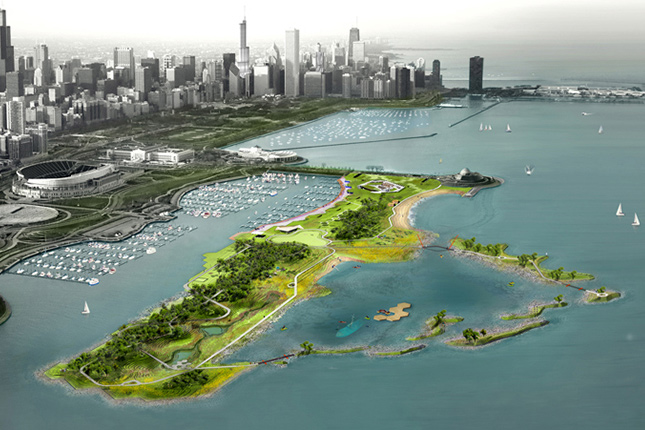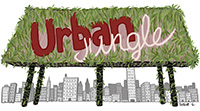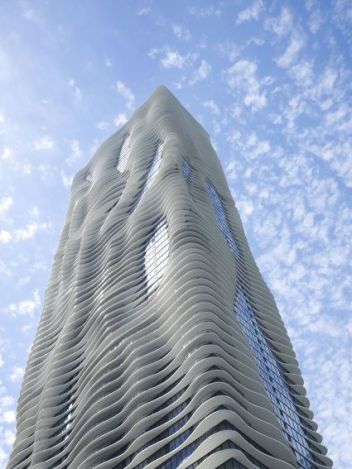
© Studio Gang ArchitectsThe Aqua tower mimics ripples on water.
In this hopeful era of returning the raw and wild to our cities, Chicago-based architect Jeanne Gang is a force of nature.
Gang’s rapid rise on the city’s toughened glass-and-steel skyline began in 2010, with the 82-story high-rise Aqua, a white, rippling form referencing water’s gentle waves. Although the Windy City had been making advances in greening and the word “sustainability” was becoming part of the local lexicon, the structure — the tallest built building designed by a woman — altered the skyline in more ways than one.
Aqua suddenly stood graceful against a mostly glass-and-steel cityscape. The skyscraper was born here, after all. But that white, undulating structure seemed to open the possibility of letting the outdoors into the city, throwing open a window, letting a fresh breeze carve its way through the hardened urban canyons. And since Aqua went up, Gang has opened that window further, with numerous structures and park spaces in and around the city, and farther afield.

Sally Ryan PhotographyJeanne Gang.
A native of rural Belvidere, Ill., Gang now has projects worldwide, including Solar Carve Tower, a tower above New York City’s High Line park, based on the relationship of the sun’s path and the building. She’s designed, among many things, structures of reused steel that resemble a tortoise shell and bird’s nests, and a roof on an outdoor theater that opens like flower petals to reveal the sky overhead. Supporting Mayor Rahm Emanuel’s vision to make the Chicago River the city’s new recreational frontier, Gang has designed two new boathouses along its banks; both will open later this summer.
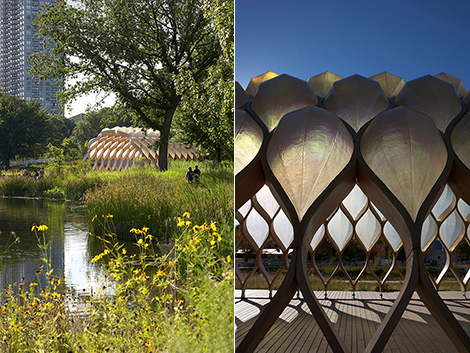
Steve Hall © Hedrich BlessingThe Nature Boardwalk at Lincoln Park Zoo is shaped like a turtle.
At 49, Gang is as lean as a tree and evokes an intense earthiness. She has a deep affinity for birds, keeping abandoned nests on a windowsill in her office.
Gang humbly shuns comparisons to Daniel Burnham, the architect who reimagined Chicago after the Great Fire of 1871 as a city in nature, establishing its grand parks and lakefront void of development. But there are obvious similarities: Gang’s vision is of dense cities teeming with green spaces, small-scale forests, and design elements that reflect or borrow from nature. She envisions fewer car lanes and more places for people to walk.
But Gang’s vision is a more modern one than Burnham’s. As she once told The New York Times, “I’ve never been one to think about nature in a pastoral, picturesque way. I think of it as a potent force that can be harnessed. Wildlife is technology … Suddenly having nature in the middle of a city can be exciting.”
Her fascination with natural and architectural form began in her childhood, when her father, a civil engineer, favored driving back roads during family vacations to marvel at local bridges. On those same trips, young Gang collected beautifully shaped rocks, packing them into her suitcase.
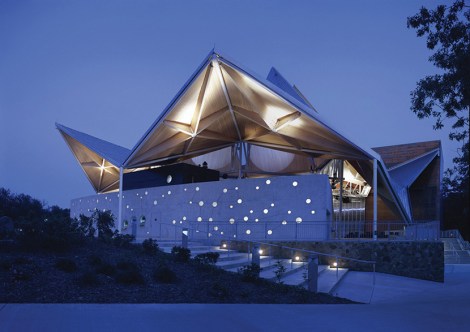
© Greg MurpheyThe Starlight Theatre in Rockford, Ill.
So the eventual evolution into an innovative architect lauded for her ability to delicately weave designs reflective of nature within the heart of cities seems, well, natural. In 1997, the Harvard grad opened her own firm, Studio Gang Architects, in a blue-collar, no-frills building in Chicago’s Wicker Park neighborhood.
After Aqua, Gang’s star rose swiftly. She soon lifted the veil on her design transforming Northerly Island, a 91-acre, human-made peninsula off the Lake Michigan shore into a park replete with wetlands, prairies, and woodlands. When the project is finished, an outer archipelago of reefs and islands will protect the park from the lake’s waves. Within it, they’ll create a harbor for fish, fishermen, divers, and kayakers.
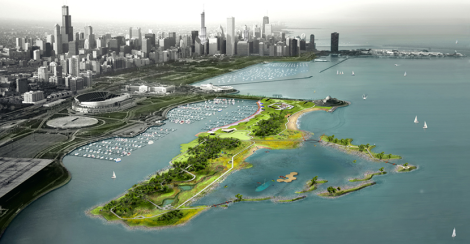
© Studio Gang ArchitectsGang’s plan for Northerly Island, a human-made peninsula in Lake Michigan
After being awarded a $500,000 MacArthur “Genius Grant” in 2011, Gang shifted her eyes to the oft-maligned Chicago River, producing a bold plan to reverse its flow. The river has already been reversed once to accommodate shipping. Her proposal would return it to its natural direction, creating a barrier between the Great Lakes and Mississippi watersheds, keeping away invasive species and ultimately transforming blighted industrial land. In her vision, several “cleaning” ponds would dot the city, providing more nature, wildlife habitat, and recreation for residents.
In her architectural work, Gang believes in sourcing from what’s available locally with emphasis on reuse or “form follows availability.” She’s insulated walls with recycled blue jeans and woven all manner of industrial castoffs into her designs. To weave “Best Nest,” the Ford Calumet Environmental Center imagined for Hegewisch Marsh, she envisions using salvaged steel, slag, glass bottles, and rebar. The structure will rise on former steel-mill brownfields land restored to migratory and nesting bird habitat.
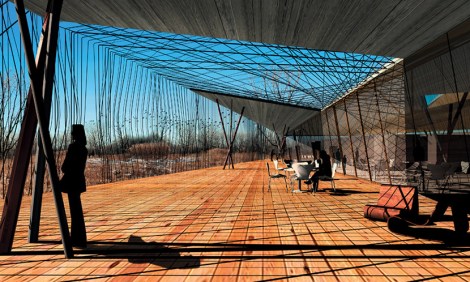
© Studio Gang ArchitectsA rendering of “Best Nest,” planned for the Ford Calumet Environmental Center
As for the cities of the future, Gang envisions the transformation of land once choked with industrial buildings being converted to green space. Urban areas, she believes, will become more dense, she says, but buildings will be designed to allow occupants to see the stars, feel the breeze, and experience more daylight via the architect’s desire to work with nature.
Herself an urban dweller who must live a “nomadic” life, Gang says she still gets many of her nature blasts within cities. “It’s a matter to know where to look,” she says.

